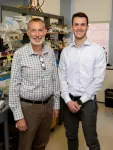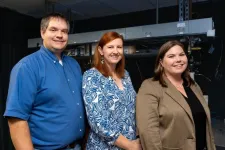(Press-News.org) As anyone who’s spent time in the saddle knows, riding a horse can be hard on your body. But can it change the way your skeleton looks?
The answer, according to archaeologists from the University of Colorado Boulder: It’s complicated. In a new study, the team drew on a wide range of evidence—from medical studies of modern equestrians to records of human remains across thousands of years.
The researchers concluded that horseback riding can, in fact, leave a mark on human skeletons, such as by subtly altering the shape of the hip joint. But those sorts of changes on their own can’t definitively reveal whether people have ridden horses during their lives. Many other activities, even sitting for long periods of time, can also transform human bones.
“In archaeology, there are vanishingly few instances in which we can tie a particular activity unequivocally to skeletal changes,” said Lauren Hosek, lead author of the study and an assistant professor in the Department of Anthropology at CU Boulder.
She and her colleagues reported their findings Sept. 20 in the journal Science Advances.
The results may have implications for researchers who study the origins of when humans first domesticated horses—and also cast doubt on a long-standing theory in archaeology known as the Kurgan hypothesis.
The first equestrians
The research lies at the center of what is among the old debates in archaeology, said William Taylor, a co-author of the new study and curator of archaeology at the CU Museum of Natural History.
He explained that the earliest, incontrovertible evidence of humans using horses for transport comes from the region around the Ural Mountains of Russia. There, scientists have uncovered horses, bridles and chariots dating back to around 4,000 years ago.
But the Kurgan hypothesis, which emerged in the early 20th century, argues that the close relationship between humans and horses began much earlier. Proponents believe that around the fourth millennium B.C., ancient humans living near the Black Sea called the Yamnaya first began galloping on horseback across Eurasia. In the process, the story goes, they may have spread a primordial version of the languages that would later evolve into English, French and more.
“A lot of our understanding of both the ancient and modern worlds hinges on when people started using horses for transportation,” Taylor said. “For decades, there’s been this idea that the distribution of Indo-European languages is, in some way, related to the domestication of the horse.”
Recently, scientists have pointed to human remains from the Yamnaya culture dating back to about 3500 B.C. as a key piece of evidence supporting the Kurgan hypothesis. These ancient peoples, the group argued, showed evidence of wear and tear in their skeletons that likely came from riding horses.
Hips can lie
But, in the new study, Hosek and Taylor argue that the story isn’t so simple.
Hosek has spent a lot of time poring over human bones to learn lessons about the past. She explained that the skeleton isn’t static but can shift and change shape over an individual’s lifetime. If you pull a muscle, for example, a reaction can emerge at the site where the muscle attaches to the underlying bone. In some cases, the bone can become more porous or raised ridges may form.
Reading those sorts of clues, however, can be murky at best. The hip joint is one example.
Hosek noted that when you flex your legs at the hip for long periods of time, including during long horse rides, the ball and socket of the hip joint may rub together along one edge. Over time, that rubbing can cause the round socket of the hip bone to become more elongated, or oval in shape. But, she said, other activities can cause the same kind of elongation.
Archaeological evidence shows that humans used cattle, donkeys and even wild asses for transport in some areas of western Asia centuries before they first tamed horses. Ancient peoples likely yoked these beasts of burden to pull carts or even smaller, two-wheeled vehicles that looked something like a chariot.
“Over time, this repetitive, intense pressure from that kind of jostling in a flexed position could cause skeletal changes,” Hosek said.
She’s seen similar changes, for example, in the skeletons of Catholic nuns from the 20th century. They never rode horses, but did take long carriage rides across the American West.
Ultimately, Hosek and Taylor say that human remains on their own can’t be used to put a date on when people first started riding horses—at least not with currently available science.
“Human skeletons alone are not going to be enough evidence,” Hosek said. “We need to couple that data with evidence coming out of genetics and archaeology and by looking at horse remains, too.”
Taylor added that the picture doesn’t look good for the Kurgan hypothesis:
"At least for now, none of these lines of evidence suggest that the Yamnaya people had domestic horses.”
END
Scientists turn to human skeletons to explore origins of horseback riding
2024-09-20
ELSE PRESS RELEASES FROM THIS DATE:
UCF receives prestigious Keck Foundation Award to advance spintronics technology
2024-09-20
UNIVERSITY OF CENTRAL FLORIDA
UCF Receives Prestigious Keck Foundation Award to Advance Spintronics Technology
The work could change the future of electronics, making them faster and more energy efficient.
ORLANDO, Sept. 20, 2024 – A team of researchers led by University of Central Florida Pegasus Professor of Physics Enrique Del Barco is working on a new project that could change the future of electronics, making them faster and more energy efficient.
The work is funded by a new $1.3 million award from the W.M. Keck Foundation, one of the nation’s ...
Cleveland Clinic study shows bariatric surgery outperforms GLP-1 diabetes drugs for kidney protection
2024-09-20
Cleveland Clinic Study Shows Bariatric Surgery Outperforms GLP-1 Diabetes Drugs for Kidney Protection
Bariatric surgery was shown to protect kidney function and reduce the risk of kidney failure in study participants when compared to GLP-1 medications
Friday, September 20, 2024, CLEVELAND: A Cleveland Clinic study showed that in patients with type 2 diabetes, obesity, and chronic kidney disease, bariatric surgery was associated with a significant decrease in the progression of chronic kidney disease compared to those who received GLP-1 diabetes medications. The paper was published in Annals ...
Study reveals large ocean heat storage efficiency during the last deglaciation
2024-09-20
As one of the largest heat reservoirs in the climate system, the global ocean absorbs more than 90% of the excess energy from ongoing anthropogenic warming. In the last century, the greatest warming in the ocean has occurred in the upper 500 m, with relatively weak warming in the deep ocean, corresponding to a small ocean heat storage efficiency of ~0.1.
Paleoceanographic observations, however, suggest that on long time scales, the deep ocean warming can be comparable to or larger than the surface ocean warming, with ocean heat storage efficiency during the last ...
Fever drives enhanced activity, mitochondrial damage in immune cells
2024-09-20
Fever temperatures rev up immune cell metabolism, proliferation and activity, but they also — in a particular subset of T cells — cause mitochondrial stress, DNA damage and cell death, Vanderbilt University Medical Center researchers have discovered.
The findings, published Sept. 20 in the journal Science Immunology, offer a mechanistic understanding for how cells respond to heat and could explain how chronic inflammation contributes to the development of cancer.
The impact of ...
A two-dose schedule could make HIV vaccines more effective
2024-09-20
One major reason why it has been difficult to develop an effective HIV vaccine is that the virus mutates very rapidly, allowing it to evade the antibody response generated by vaccines.
Several years ago, MIT researchers showed that administering a series of escalating doses of an HIV vaccine over a two-week period could help overcome a part of that challenge by generating larger quantities of neutralizing antibodies. However, a multidose vaccine regimen administered over a short time is not practical for mass vaccination campaigns.
In a new study, the researchers have now found that they ...
Wastewater monitoring can detect foodborne illness, researchers find
2024-09-20
UNIVERSITY PARK, Pa. — First used in the 1940s to monitor for polio, wastewater surveillance proved such a powerful disease monitoring tool that the U.S. Centers for Disease Control and Prevention (CDC) established the National Wastewater Surveillance System to support SARS-CoV-2 monitoring in September of 2020. Now, a team of scientists from Penn State and the Pennsylvania Department of Health have shown that domestic sewage monitoring is useful for a foodborne pathogen as well.
In findings published today (Sept. 19) in the Journal of Clinical ...
Kowalski, Salonvaara receive ASHRAE Distinguished Service Awards
2024-09-20
Building equipment and envelope scientists at the Department of Energy’s Oak Ridge National Laboratory were recognized for research excellence during the ASHRAE 2024 summer conference held in Indianapolis.
Stephen Kowalski and Mikael Salonvaara received the Distinguished Service Award, which salutes members who have served the society with distinction in chapter, regional and society activities. Kowalski and Salonvaara have each been active members of ASHRAE for more than 25 years and have supported the organization’s Technical and Standards Project Committees.
ASHRAE is the largest international professional organization ...
SkAI launched to further explore universe
2024-09-20
Funded by a five-year, $20 million grant from the U.S. National Science Foundation (NSF) and the Simons Foundation, the National Center for Supercomputing Applications is partnering with other academic institutions and federal laboratories in the Midwest to develop new artificial intelligence (AI) tools to advance astrophysics research and exploration of the universe.
Led by Northwestern University, the collaboration will establish the NSF-Simons AI Institute for the Sky or SkAI (pronounced “sky”), one of two AI research centers that will help astronomers better understand the cosmos.
Located close to NCSA’s home in Illinois, SkAI will ...
SLU researchers identify sex-based differences in immune responses against tumors
2024-09-20
ST. LOUIS — Researchers at Saint Louis University School of Medicine investigated differences in T-cell responses between male and female patients with lung cancer that may help direct future treatments. T-cell responses are part of the adaptive immune system, part of the body’s “smart system” that monitors for threats and fights them with customized defenses.
"Therapies that use the patient's immune system to fight their disease have a lot of potential to ...
Evolved in the lab, found in nature: uncovering hidden pH sensing abilities
2024-09-20
By Andy Flick, Evolutionary Studies scientific coordinator
In a groundbreaking study led by Sarah Worthan, Ph.D., a postdoctoral researcher in the Behringer Lab at Vanderbilt University, scientists have successfully evolved microbial cultures that possess the ability to sense pH changes, enabling rapid responses to environmental fluctuations. Along with highlighting the power of lab-driven evolution, this discovery also led to finding similar mutations in nature in emerging pathogens and coral symbionts—organisms that navigate challenging pH shifts in their environments and are ...




